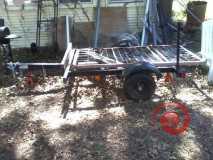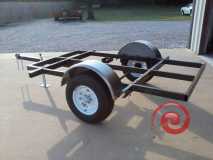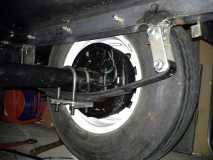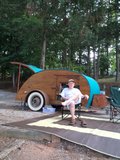swoody126 wrote:hubs would cost more in the beginning
spacers involve 10 more studs and 10 more nuts to deal with
do it right to start with, get new hubs and be done with it
that'z this old man's 2¢ worth at sunrise on this beautiful Sunday morning
sw
*Since your trailer is very light, I see no problem using even cheap spacer/adapters on it, but if you're planning on heavy-duty additions, or rugged travel, then upgrading your hubs/bearings will be the best option for you. I started mine by skimping on initial outlay, though I did add new, larger hubs and spacers (after it turned out to need wider spacing, due to wider tires - going from 8" to 14" tires).
*Probably spent $160. (
I should've just upgraded to a better complete axle at the time!): $80 for new 5-lug (converting from 4 to 5 lug wheels) hub/bearing sets + another $80 for 5 lug-5 lug 1.25" spacers. Here's are excerpts from previous thread(s) on this matter:
working on it wrote:- My original axle was very small, with 8" wheels. I absolutely refused to consider using that size wheel, and momentarily considered getting 12" wheels (which were on sale at Northern Tool, at the time), but decided to go bigger, into familiar territory, by using automotive-sized wheels with bigger, cooler-running bearings. I've had many cars with tires in the 14"-16" size range, and never had any wheel bearing problems with any, so that was proof of the bigger wheel/bearing theory to me.
- I was on a very limited build budget at the time, making me stay with the small axle, but I sourced big bearings/hubs (with five lugs, for automotive/trailer wheels) pretty cheaply thru a friend, and my eventual choice of using 14" wheels was for build economy, too. I did spend a large amount (comparatively) on a set of quality adapter/spacers to make the 14" wheels/tires fit, but I've used many spacers over the years, and these were better than any, so I had no qualms about using them.
- I always planned on a braked axle upgrade, later, for when I could justify the expense vs just getting by, so I agree that braking is very important, and should be added to any trailer as soon as possible, though my TV truck didn't require that the trailer had any. Here's my comments concerning these subjects from an earlier thread, Trailer Selection Help http://www.tnttt.com/viewtopic.php?f=35&t=68873&hilit=adapters+wheel#p1209647:
- If there's any question in your mind of having future problems using the stock
(boat trailer) axle/bearings/wheels/tires, especially trailering at high speeds (I tow at 75 mph), or going off-road, or building a trailer near or over the axle's rated capacity, then just go ahead and upgrade now, if your budget affords it. Retro-fitting later, as in my case, limits choices and is harder to do than at the early build stages. I knew I would need better running gear, eventually, but I piecemeal-ed the improvements over time, due to having a low-or-no budget situation, at the start. You have the opportunity to upgrade now, before problems arise later. - The "junk" trailer I started with had 8" wheels on a 1.25" square-tubed axle, of unknown weight capacity, so I put larger bearings and 5 on 4.5 hubs (replacing the 4 lug originals) so I could use 14" tires on it. I chose 14" tires because they are the same size that my wife's business trailer has (so I could get a free spare, to share), and a friend had two extra 14" tires on hand. There was no way I would've trusted my trailer build to using the smaller tires and bearings on highways, especially since I had burnt up one of the original bearings, just bringing the "junk" trailer back from a swap-meet 20 years before. I also had to use 1.25" wheel spacer/adapters to make the larger tires clear the frame.
- I always intended to make my trailer a "heavy-duty" off-road type, just in case I or my wife would ever need it to go to out-of-the-way campsites, so larger tires were a better choice, though I wanted to eventually replace the light-duty axle before any excursion on rougher roads, in the future. As it turned out, I had the opportunity to upgrade my axle after a spring hanger tore loose, so I bought a 3500 lb Dexter (wider than the original, thus eliminating the spacers), adding brakes and better springs, and reinforced the frame at that time. Still on a limited budget, though I had improved the axle situation, I still used my aged and patched ST tires for two more years (they were at least 12 years old by then), before replacing them with good LT tires.
- Now, after upgrading all the suspension and rolling stock, I have no worries travelling at high speeds, or over rough terrain. But, to do it again, I would've built it from the ground up, rather than correcting mistakes or bad choices, later on.
 starting point; needs a lot of work, obviously
starting point; needs a lot of work, obviously enlarged frame, same axle (with larger bearings/wheels)
enlarged frame, same axle (with larger bearings/wheels) original spindly axle (unknown capacity)
original spindly axle (unknown capacity) Dexter 3500 lb axle & better springs
Dexter 3500 lb axle & better springs



